The rise in autonomous vehicles is happening faster than many people think. NVIDIA CEO, Jensen Huang, says that fully automated vehicles will be on our roads by 2022, while Scott Keogh, Head of Audi America has promised that Audi would have its first self-driving cars ready to purchase by as early as 2020.
So, with the rapid acceleration of the autonomous vehicle (AV) market, what are the main challenges we face as urban designers? And how will autonomous vehicles affect the urban fabric of our cities?
Towards a New Autopia?
Throughout the latter half of the 20th century, our urban and suburban environments have been primarily designed for private car use. However, there has been a recent reduction in the ownership of private vehicles. Thanks to on-demand ridesharing services like Uber and Lyft, and specific vehicle demand management policies.
Drivers of change
The reduced number of vehicles on our roads has already begun to shape the fabric of the city. Projects like Berges de Seine Paris and Rhone River Bank Lyon show how spaces in the city that were once dominated by the automobile can be converted to public open spaces that serve the city and its inhabitants.
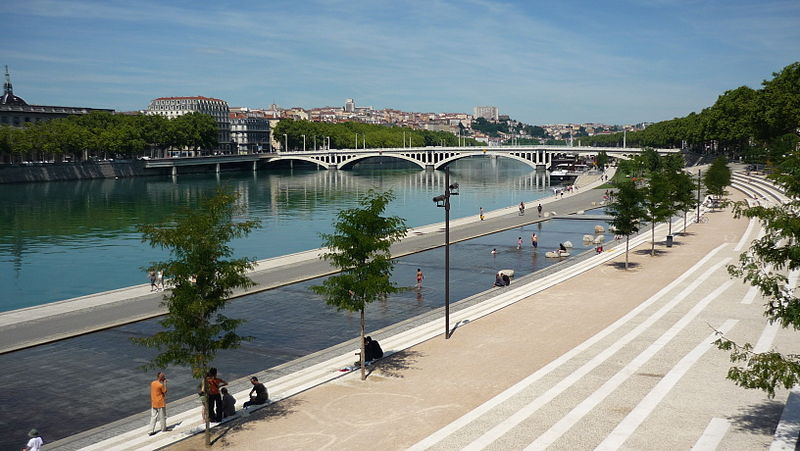
Berges_du_Rhone_Pont_Guillotiere by ThomasBigot
This is a trend set to continue. As any technology (and its associated manufacturing techniques) develops it becomes cheaper. This will drive the demand for AVs as more consumers and companies will be able to afford the technology. Some experts predict that sales of AVs will pass 33 million a year by 2040 (representing one-quarter of all car sales).
Rethink (a think tank focused on the future of technology) believes that private car ownership will reduce in favour of on-demand services where massive fleets of AVs are owned by private companies. However, the recent tragic events of Uber’s fatal autonomous vehicle accident has spread skepticism among the media.
Finally, the policy on how AVs may be driven in our cities is somewhat behind the technology and implementation. The Global Survey of Autonomous Vehicle Regulations notes that only 33 US states have legislation covering self-driving cars on public roads, and other countries like the UK, Netherlands and Sweden only have fully enacted legislation covering the testing of autonomous vehicles. Many other countries have no legal framework covering AVs.
Updating the hardware to meet new software
If by 2030 some 25% of cars on the road will be AVs, we should be adapting our cities now to accommodate this change and preparing for the time when all cars will be autonomous.
Currently, AVs use LiDAR to scan the road ahead. This technology is best at reading the road ahead at between 100-200 m. However, by incorporating roadside sensors along the length of a road, information about road condition, weather, and unexpected events can be relayed to all cars simultaneously. It is likely we shall need to accommodate some form of sensing equipment along our streets in the future. A key challenge is how this is incorporated into the streetscape and could mean the difference between an ugly retro-fitted solution, and a properly integrated system that augments the built environment.
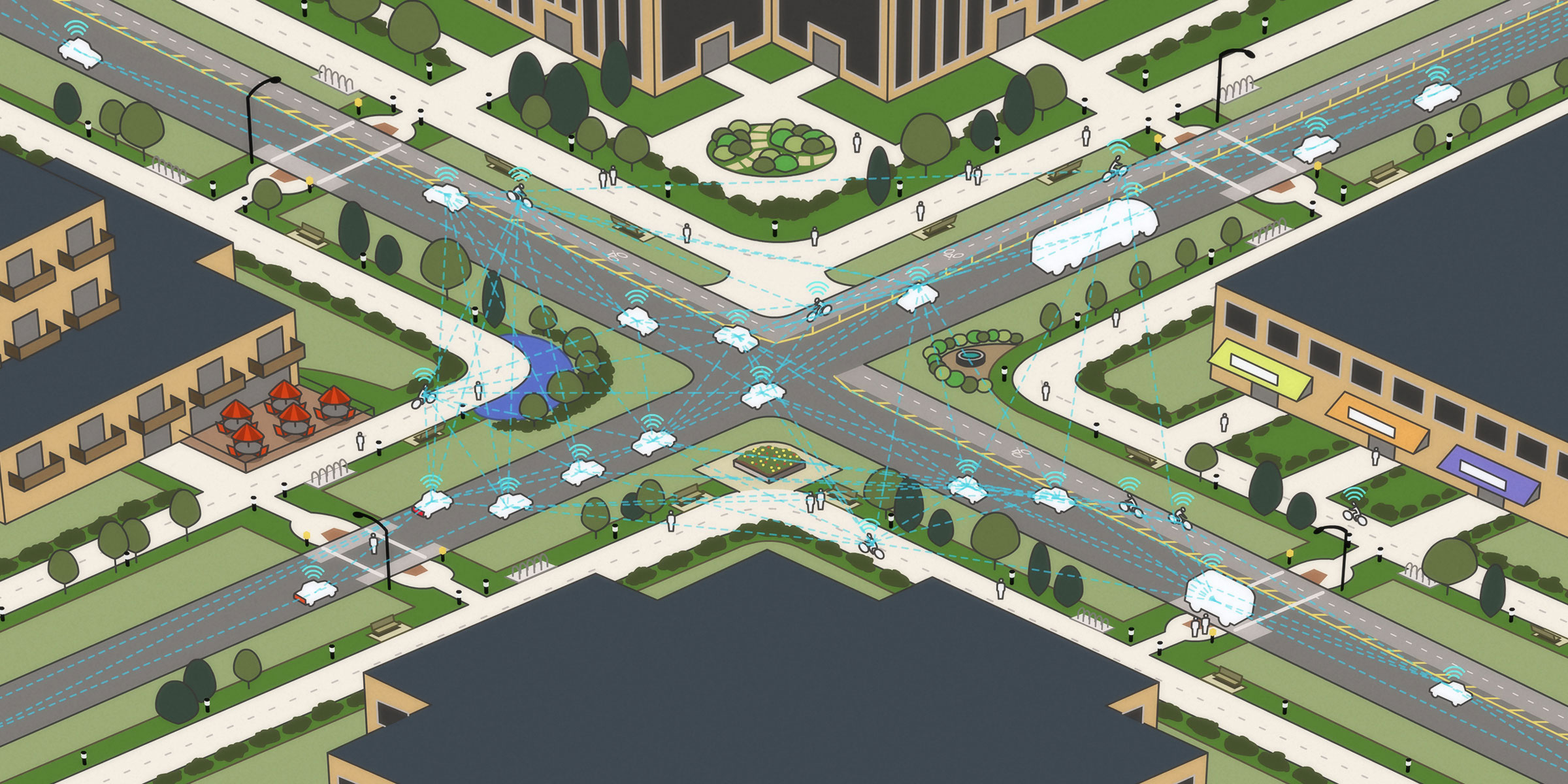
Image courtesy of Short Elliott Hendrickson Inc. (SEH®) http://www.sehinc.com
One benefit of better connected AVs is the opportunity to give higher priority to pedestrians. The present car-centric design of our cities means that pedestrians are forced to walk to the nearest road junction or underpass to safely cross the road. With cars being driven by computers with faster reaction times, truly shared surfaces can be used throughout the city. A walkable city with a more attractive environment for pedestrians can have dramatic effects including lower crime, physically and mentally healthier citizens, and increased property prices.
With reduced numbers of cars comes reduced spatial requirements. Even if numbers of cars do not fall dramatically, some experts predict that efficiencies in automating traffic flows mean vehicles will be able to drive at higher densities. Roads will, therefore, be able to be narrower, with fewer lanes. In existing urban areas this means wider sidewalks that can accommodate other functions such as linear parks, sustainable urban drainage systems and dedicated drone delivery lanes.
When 100% of vehicles are self-driving, there will no longer be a need for vehicular road signage and traffic lights. This presents an opportunity to de-clutter our streetscapes and come up with innovative new solutions to allow AVs to communicate with each other. Pedestrian wayfinding will remain a consideration, but without the need to display signage for motorists, we can rethink how people navigate the city.
Parks instead of parking
The use of shared on-demand vehicles will reduce the redundancy of cars as they are in use for longer periods of time. Real-time relaying of information directly to AVs will reduce the time spent searching for parking places. Self-driving cars will be able to drop off their passengers at their destination, and then leave to either pick up a new passenger or find a centralized parking and charging location. The reduction in localized car parking facilities will free up more space in the city for parks such as at Tongva Park in Santa Monica by James Corner Field Operations.
On a smaller scale, the reduced ownership of cars will result in private homes not requiring dedicated garages and driveways. This will affect housing design allowing for the development of a higher density within cities and the suburbs.
Future cities
For the last 60 years or so, the private car has dominated urban design. But the rise in autonomous vehicles presents some unique challenges and opportunities to reassess how our cities are designed.
The increase in on-demand driverless vehicles will result in more space in our cities for green infrastructure. Areas that were once dominated by localized parking lots can be converted into pocket parks. Wide boulevards and urban highways can be repurposed into pleasant greenways. Roads can become narrower, allowing for better sustainable urban drainage systems and blue infrastructure. Higher priority can be given to pedestrians in truly walkable cities that will benefit our mental and physical health.
The technology behind autonomous vehicles is progressing at a fast pace. While policy and infrastructure design might be slightly behind the technological advances, it is time designers started to think about the changes that will come and plan for a future in which the car is no longer.
—
Lead Image: Hämeenlinnanväylä kaupunkibulevardina by Mikko Uro c. Helsinki City



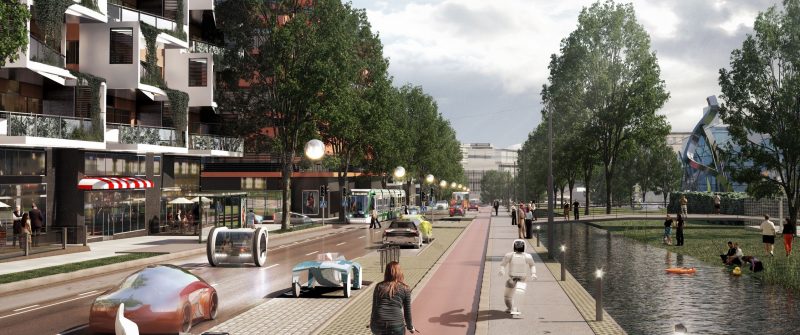

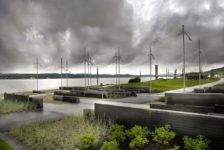


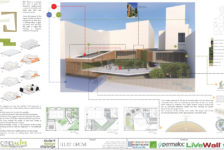





J. Robert (Bob) Wainner
Just a few thoughts and opinions here. IMO, if our society were to convert to a transportation system that was, say, even as low as 75% electric driven…..it would put a major strain on our U.S. power grid. Plus, that would make our Nation very vulnerable to cyber attacks by our enemies on our electric grid….and I have read, enemy nations have already been trying to hit our grid. Even North Korea has threatened to do this…one well placed nuke on our electric grid, would paralyze our entire Nation. In addition, the ideas and concepts presented in this article are a bit optimistic to say the least. Maybe, I said “maybe” the U.S. might one day be OK with some of these concepts…but, good luck convincing the rest of the World Nations to do this. Unless we can figure out how to build a “glass dome” over the U.S…how do we keep other Nation’s CO2 emissions out of the U.S.? In addition, it we implemented all of the ideas suggested in this article…going with a somewhat AI driven society…think of ALL of the lost jobs! Taxi & bus drivers, car manufacturing industry, auto repair shops and auto part stores….this list would be very long. And, WHERE does all the financing come from to implement these ideas? More taxes? And, I actually enjoy driving my sports car and going where and when I want to go some place. I don’t want to call a driverless car to come pick me up. Too many of these ideas sound very “utopian” and farfetched, IMO.
J. Robert (Bob) Wainner
Jolma Architects
Many thanks for taking the time to read our article and for your considered thoughts and opinions.
I agree that many national grids would currently not be able to cope with a 75% market share of electric vehicles. Luckily, we are quite a long way off such a high share. While we need to plan ahead, I think the grid will have time to increase capacity through a diverse portfolio of energy supplies. Also, it is already possible to stagger over-night charging to use the grid when it is in less demand. In fact, it might even be possible to use centralised parking and charging stations to even out some of the fluctuations in green energy production.
As for cyber security and the vulnerabilities of the national grid in the US, you make a good point. This is somewhat outside of the remit of urban design, but no doubt a consideration that should be taken into account.
Regarding decreasing CO2 emissions, any decrease globally is of benefit. Not decreasing net emissions because those of other countries cannot be excluded, does nothing to reduce CO2 and move towards a more sustainable future. Also, CO2 is not the only pollutant caused by vehicles. By decreasing the amount of fossil fuel vehicles on the road, local levels of particulates, CO, NO, SO2 and PAHs are decreased. This has direct health benefits for local neighbourhoods.
You make a good point about the short-term loss of jobs. Many people raise concerns about AI decreasing jobs. However, this will be somewhat off-set by increases in jobs in areas such as servicing, coding/programming, data management, R&D, etc. Throughout history advances in technology has lead to jobs being lost and created. Let’s see where this leads.
I agree with your point about liking to drive your sports car. I’m sure many people enjoy driving. That’s why I think Rethink’s ideas about uber-style fleets of AVs is probably most sensible. I think AVs probably appeal mostly to those who don’t care to drive. As is well documented, fewer millennials are learning to drive. I think in the future there will be fewer and fewer keen drivers which will coincide with an increase in driverless cars.
Best regards,
Ashley D Penn.